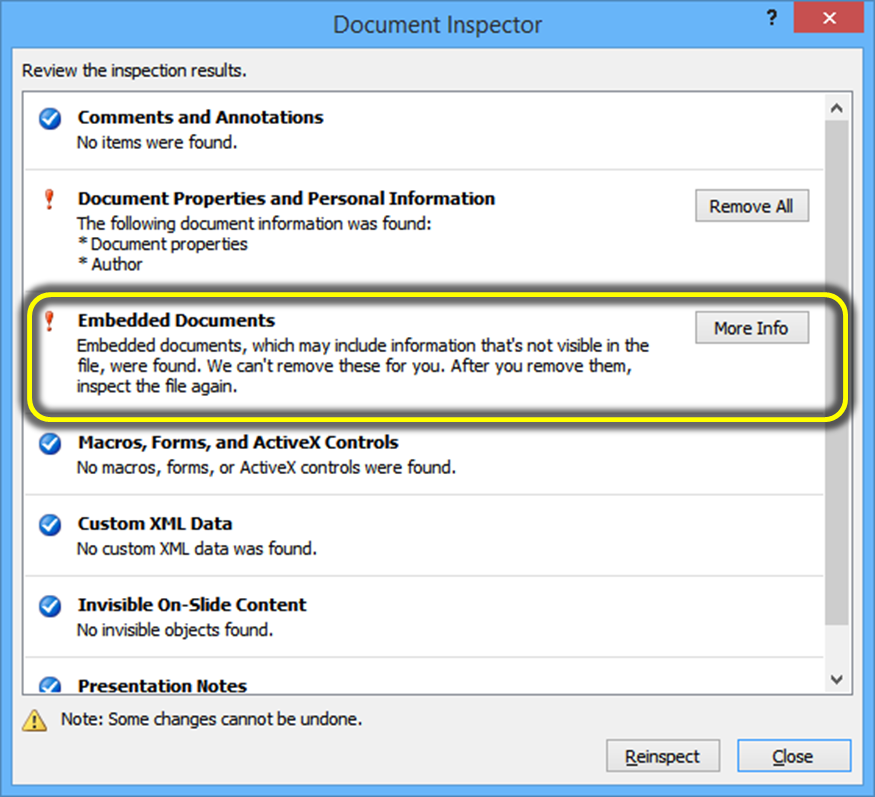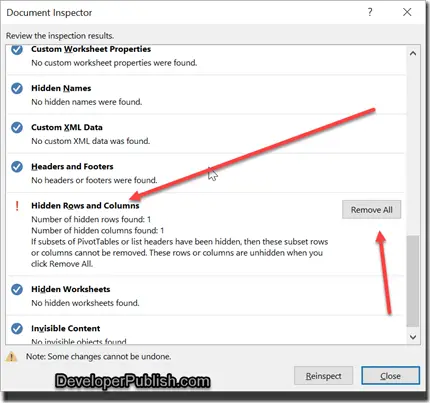Finding embedded OLE objects within a presentation is very time-consuming and prone to human error, which can leave you pulling your hair out in frustration. Whether the objects are large, or you need to avoid distributing sensitive data hidden behind an Excel chart, the Slidewise PowerPoint add-in will instantly show you any embedded objects or chart data in your presentation and let you jump straight to them.
- Free Powerpoint For Mac
- Debug Office Add-ins On A Mac - Office Add-ins | Microsoft Docs
- Secrets Left In Docs After Document Inspector In Office ...
- Powerpoint For Mac Document Inspector 2019
- Document Inspector Mac
- Cached
Find embedded objects in PowerPoint with Slidewise
Beginning with the November and December 2014 updates for Microsoft Office 2013 and 2010, several enhancements are being added to the Document Inspector, also known as the “Check for Issues” tool. Collaborate for free with an online version of Microsoft PowerPoint. Save presentations in OneDrive. Share them with others and work together at the same time. In your original document, click the File tab and then click Info. You will see some of the hidden information on the right. Click the Check for Issues icon shown in a box and then click Inspect Document. In the Document Inspector window, select at a minimum, the following options. There are some things not covered by the Document Inspector that could cause embarrassing. When will the Recording tab come to PowerPoint for Mac?
- Download the free trial of Slidewise and open it from the ribbon
- It will automatically build an index of all the objects in your presentation. Look down the tree for Embedded chart data and/or Embedded objects - you can see immediately how many objects you have and how big they are.
- Expand the nodes to show all the objects, double-click to jump to a specific object in your presentation.
Grab your free 14-day trial of Slidewise today, and see how incredibly helpful it can be.
How to replace an embedded object with a picture
In order to reduce file size, or if you have an embedded Excel chart and you want to eliminate the hidden data, you can change objects to pictures by following this simple procedure.
- Select the chart or object and press Ctrl+C.
- Right-click on the slide and select paste as picture (highlighted below)
- Select the original embedded chart or object and press Delete.
Finding embedded objects in PowerPoint manually
If you can’t use Slidewise for some reason, then here are steps you can use to tell if your presentation has embedded objects, check their total size, and how to manually find objects on your slides without using extra tools.
Firstly, you can see if you have any embedded objects by using the document inspector (File > Check for issues > Inspect document). If you do then you’ll see a warning like this:
If embedded documents have been inserted using the “Display as icon” option then they should be fairly easy to spot, directly on the slide - just look for things like this:
However, many objects may just look like images or charts, making it difficult to pick them out on the slide. To help you find them more easily open the Selection Pane (Home tab > Select > Selection Pane…).
Then click through each slide in your presentation looking out for any shapes that are named “Object...”, as shown in the picture below.
How to check the size of embedded objects
It isn’t possible to see how large objects are using PowerPoint. So if you need to find out how much of your presentation size is caused by objects you can use this method instead.
In Explorer change the .pptx file extension of your presentation to .zip and double click it to open the contents.
Note: You may need to make file extensions visible, by selecting the “View” tab in the ribbon and then checking “File name extensions”, as shown here:
Look inside the pptembeddings folder to see a list of the objects and how big they are.
-->The Document Inspector gives users an easy way to examine documents for personal or sensitive information, text phrases, and other document contents. They can use the Document Inspector to remove unwanted information; for example, before distributing a document.
Note
Microsoft does not support the automatic removal of hidden information for signed or protected documents, or for documents that use Information Rights Management (IRM). We recommend that you run the Document Inspector before you sign a document or invoke IRM on a document.
As a developer, you can use the Document Inspector framework to extend the built-in modules and integrate your extensions into the standard user interface.
The Document Inspector in Word, Excel, and PowerPoint includes the following enhancements.
Built-in Document Inspector modules
The Document Inspector has modules that help users inspect and fix specific elements of a given document. The Document Inspector includes the following built-in modules.
For all Office documents
- Embedded documents
- OLE objects and packages
- Data models
- Content apps
- Task Pane apps
- Macros and VBA modules
- Legacy macros (XLM and WordBasic)
For Excel documents
- PivotTables and slicers
- PivotCharts
- Cube formulas
- Timelines (cache)
- Custom XML data
- Comments and annotations
- Document properties and personal information
- Headers and footers
- Hidden rows and columns
- Hidden worksheets and names
- Invisible content
- External links and data functions
- Excel surveys
- Custom worksheet properties
For PowerPoint documents
- Comments and annotations
- Document properties and personal information
- Invisible on-slide content
- Off-slide content
- Presentation notes
For Word documents

- Comments, revisions, versions, and annotations
- Document properties and personal information; this includes metadata, SharePoint properties, custom properties, and other content information
- Custom XML data
- Headers, footers, and watermarks
- Invisible content
- Hidden text
Opening the Document Inspector
Free Powerpoint For Mac

Debug Office Add-ins On A Mac - Office Add-ins | Microsoft Docs
To open the Document Inspector:
Secrets Left In Docs After Document Inspector In Office ...
Choose the File tab, and then choose Info.
Choose Check for Issues.
Choose Inspect Document.
Use the Document Inspector dialog box to select the type or types of data to find in the document.
After the modules complete the inspection, the Document Inspector displays the results for each module in a dialog box. If a given module finds data, the dialog box includes a Remove All button that you can click to remove that data. If the module does not find data, the dialog box displays a message to that effect.
Powerpoint For Mac Document Inspector 2019
If you choose to remove the data for a given module, the dialog box displays descriptive text that indicates whether the operation was successful or not. If the Document Inspector encounters errors during the operation, the module is flagged, displays an error message, and the data for that module does not change.
Document Inspector Mac
Support and feedback
Cached
Have questions or feedback about Office VBA or this documentation? Please see Office VBA support and feedback for guidance about the ways you can receive support and provide feedback.